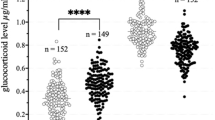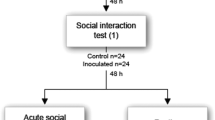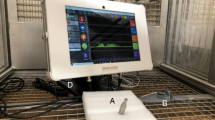Abstract
The type and location of fire alarms are important considerations in animal facility design. The Guide for the Care and Use of Laboratory Animals recommends minimizing animal exposure to such alarms. Nevertheless, it is often necessary to maintain fire alarms within animal housing or procedural areas. The authors exposed male mice to the flashing strobe light component of a standard fire alarm and evaluated mouse fecal corticosterone concentration, which is known to be an indicator of stress. Mice were exposed to the strobe light for 5 min during either the light or the dark phase of the light:dark cycle. The authors collected fecal samples every 6 h for 24 h before exposing mice to the alarm and every 6 h for 24 h after exposure. Fecal samples taken before exposure (baseline samples) showed a normal circadian pattern of corticosterone metabolite excretion. In fecal samples taken after mice were exposed to the fire alarm, metabolite concentrations did not significantly differ from baseline concentrations over time.
This is a preview of subscription content, access via your institution
Access options
Subscribe to this journal
We are sorry, but there is no personal subscription option available for your country.
Buy this article
- Purchase on Springer Link
- Instant access to full article PDF
Prices may be subject to local taxes which are calculated during checkout




Similar content being viewed by others
References
Clough, G. & Fasham, J.A.L. A 'silent' fire alarm. Lab. Anim. 9, 193–196 (1975).
Turner, J.G., Parrish, J.L., Hughes, L.F., Toth, L.A. & Caspary, D.M. Hearing in laboratory animals: strain differences and nonauditory effects of noise. Comp. Med. 55, 12–23 (2005).
Willott, J.F. Factors affecting hearing in mice, rats and other laboratory animals. J. Am. Assoc. Lab. Anim. Sci. 46, 23–27 (2007).
National Fire Protection Agency. NFPA 72 National Fire Alarm Code (National Fire Protection Agency, Quincy, 2007).
Anisman, H., Prakash, P., Merali, Z. & Poulter, M.O. Corticotropin releasing hormone receptor alterations elicited by acute and chronic unpredictable stressor challenges in stressor-susceptible and resilient strains of mice. Behav. Brain Res. 181, 180–190 (2007).
Busnel, R.G., Busnel, M.C. & Lehmann, A.G. Synergic effects of noise and stress on general behavior. Life Sci. 16, 131–137 (1975).
de Wazieres, B. et al. Effect of an auditory stress on perito-neal and alveolar cells in C57 BL/6J mice of advanced age. Luminescence 15, 233–237 (2000).
Haque, S.F. et al. Anesthesia and acoustic stress-induced intra-uterine growth retardation in mice. J. Reprod. Dev. 50, 185–190 (2004).
Kugler, J., Kalveram, K.T. & Lange, K.W. Acute, not chronic, exposure to unpredictable noise periods affects splenic lymphocytes and plasma corticosterone in the mouse. Int. J. Neurosci. 51, 233–234 (1990).
Monjan, A.A. & Collector, M.I. Stress-induced modulation of the immune response. Science 196, 307–308 (1977).
Nunez, M.J. et al. Music, immunity and cancer. Life Sci. 71, 1047–1057 (2002).
Institute of Laboratory Animal Resources, National Research Council. Guide for the Care and Use of Laboratory Animals 36, 77 (National Academy, Washington, DC, 1996).
Parfitt, D.B., Walton, J.R., Corriveau, E.A. & Helmreich, D.L. Early life stress effects on adult stress-induced cortico-sterone secretion and anxiety-like behavior in the C57BL/6 mouse are not as robust as initially thought. Horm. Behav. 52, 417–426 (2007).
Turner, J.G., Baurer, C.A. & Rybak, L.P. Noise in animal facilities: why it matters. J. Am. Assoc. Lab. Anim. Sci. 46, 10–13 (2007).
van Raaij, M.T.M., Oortgiesen, M., Timmerman, H.H. & Dobbe, C.J.G. & van Loveren, H. Time-dependent differential changes of immune function in rats exposed to chronic intermittent noise. Physiol. Behav. 60, 1527–1533 (1996).
Vitale, F., Arletti, R. & Sandrini, M. Acute noise stress analgesia in relation to 5-HT2 and mu-opioid receptor changes in the frontal cortex of young mice. Life Sci. 77, 2500–2513 (2005).
Zheng, K.C. & Ariizumi, M. Modulations of immune functions and oxidative status induced by noise stress. J. Occup. Health 49, 32–38 (2007).
Zondek, B. & Tamari, I. Effect of audiogenic stimulation on genital function and reproduction. Am. J. Obstet. Gynecol. 80, 1041–1048 (1960).
Zondek, B. & Tamari, I. Effect of audiogenic stimulation on genital function and reproduction: III. Infertility induced by auditory stimuli prior to mating. Acta Endocrinol. (Copenh). 45 Suppl., 227–234 (1964).
Balsalobre, A. et al. Resetting of circadian time in peripheral tissues by glucocorticoid signaling. Science 289, 2344–2347 (2000).
Cavigelli, S.A. et al. Fecal corticoid metabolites in aged male and female rats after husbandry-related disturbances in the colony room. J. Am. Assoc. Lab. Anim. Sci. 45, 17–21 (2006).
Davidson, A.J. et al. Chronic jet-lag increases mortality in aged mice. Curr. Biol. 16, R914–916 (2006).
Demas, G.E. & Nelson, R.J. Photoperiod and temperature interact to affect immune parameters in adult male deer mice (Peromyscus maniculatus). J. Biol. Rhythms 11, 94–102 (1996).
Jacoby, R.O., Fox, J.G. & Davisson, M. in Laboratory Animal Medicine 2nd edn. (eds. Fox, J.G., Anderson, L.C., Loew, F.M. & Quimby, F.W.) 35–120 (Academic, Amsterdam, 2002).
Leproult, R., Colecchia, E.F., L'Hermite-Baleriaux, M. & van Cauter, E. Transition from dim to bright light in the morning induces an immediate elevation of cortisol levels. J. Clin. Endocrinol. Metab. 86, 151–157 (2001).
Roedel, A., Storch, C., Holsboer, F. & Ohl, F. Effects of light or dark phase testing on behavioural and cognitive performance in DBA mice. Lab. Anim. 40, 371–381 (2005).
Scheer, F.A.J. L & Buijs, R.M. Light affects morning salivary cortisol in humans. J. Clin. Endocrinol. Metab. 84, 3395–3398 (1999).
Shigeyoshi, Y. et al. Light-induced resetting of a mammalian circadian clock is associated with rapid induction of the mPer1 transcript. Cell 91, 1043–1053 (1997).
Touma, C., Sachser, N., Mostl, E. & Palme, R. Effects of sex and time of day on metabolism and excretion of corticosterone in urine and feces of mice. Gen. Comp. Endocrinol. 130, 267–278 (2003).
Valentinuzzi, V.S. et al. Locomotor response to an open field during C57BL/6J active and inactive phases: differences dependent on conditions of illumination. Physiol. Behav. 69, 269–275 (2000).
van der Meer, E., van Loo, P.L. & Baumans, V. Short-term effects of a disturbed light-dark cycle and environmental enrichment on aggression and stress-related parameters in male mice. Lab. Anim. 38, 376–383 (2004).
Ishida, A. et al. Light activates the adrenal gland: timing of gene expression and glucocorticoid release. Cell Metab. 2, 297–307 (2005).
Bourin, M. & Hascoët, M. The mouse light/dark box test. Eur. J. Pharmacol. 463, 55–65 (2003).
Hascoët, M., Bourin, M. & Dhonnchadha, B.A. The mouse light-dark paradigm: a review. Prog. Neuropsychopharmacol. Biol. Psychiatry 25, 141–166 (2001).
Zalcman, S., Kerr, L. & Anisman, H. Immunosuppression elicited by stressors and stressor-related odors. Brain Behav. Immun. 5, 262–273 (1991).
Kapoor, A. & Matthews, S.G. Short periods of prenatal stress affect growth, behaviour and hypothalamo-pituitary-adrenal axis activity in male guinea pig offspring. J. Physiol. 566, 967–977 (2005).
Barrett, A.M. & Stockham, M.A. The effect of housing conditions and simple experimental procedures upon the corticosterone level in the plasma of rats. J. Endocrinol. 26, 97–105 (1963).
Chelini, M.O., Souza, N.L., Cortopassi, S.R.G., Felippe, E.C.G. & Oliveira, C.A. Assessment of the physiologic stress response by quantification of fecal corticosteroids. J. Am. Assoc. Lab. Anim. Sci. 45, 8–11 (2006).
Good, T., Khan, M.Z. & Lynch, J.W. Biochemical and physiological validation of a corticosteroid radioimmunoassay for plasma and fecal samples in oldfield mice (Peromyscus polionotus). Physiol. Behav. 80, 405–411 (2003).
Halberg, F., Albrecht, P.G. & Bittner, J.J. Corticosterone rhythm of mouse adrenal in relation to serum corticosterone and sampling. Am. J. Physiol. 197, 1083–1085 (1959).
Laber, K., Veatch, L.M., Lopez, M.F., Mulligan, J.K. & Lathers, D.M.R. Effects of housing density on weight gain, immune function, behavior, and plasma corticosterone concentrations in BALB/c and C57BL/6 mice. J. Am. Assoc. Lab. Anim. Sci. 47, 16–23 (2008).
Lipman, N.S. & Perkins, S.E. in Laboratory Animal Medicine 2nd edn. (eds. Fox, J.G., Anderson, L.C., Loew, F.M. & Quimby, F.W.) 1143–1184 (Academic, Amsterdam, 2002).
O'Malley, J., Dambrosia, J.M. & Davis, J.A. Effect of housing density on reproductive parameters and corticosterone levels in nursing mice. J. Am. Assoc. Lab. Anim. Sci. 47, 9–15 (2008).
Parfitt, D.B. et al. Differential early rearing environments can accentuate or attenuate the responses to stress in male C57BL/6 mice. Brain Res. 1016, 111–118 (2004).
Smagin, G.N., Heinrichs, S.C. & Dunn, A.J. The role of CRH in behavioral responses to stress. Peptides 22, 713–724 (2001).
Tanito, M. & Anderson, R.E. Bright cyclic light rearing-mediated retinal protection against damaging light exposure in adrenalectomized mice. Exp. Eye Res. 83, 697–701 (2006).
Touma, C., Palme, R. & Sachser, N. Analyzing corticosterone metabolites in fecal samples of mice: a noninvasive technique to monitor stress hormones. Horm. Behav. 45, 10–22 (2004).
Wright-Williams, S.L., Courade, J.P., Richardson, C.A., Roughan, J.V. & Flecknell, P.A. Effects of vasectomy surgery and meloxicam treatment on faecal corticosterone levels and behaviour in two strains of laboratory mouse. Pain 130, 108–118 (2007).
Shackleton, C.H.L Hughes, B.A., Lavery, G.G., Walker, E.A. & Stewart, P.M. The corticosteroid metabolic profile of the mouse. Steroids 73, 1066–1076 (2008).
Dalm, S. et al. Age-related changes in hypothalamic-pituitary-adrenal axis activity of male C57BL/6J mice. Neuroendocrinology 81, 372–380 (2005).
Cavigelli, S.A. et al. Frequent serial fecal corticoid measures from rats reflect circadian and ovarian corticosterone rhythms. J. Endocrinol. 184, 153–163 (2005).
Grouzmann, E et al. Blood sampling methodology is crucial for precise measurement of plasma catecholamines concentrations in mice. Eur. J. Physiol. 447, 254–258 (2003).
Bamberg, E., Palme, R. & Meingassner, J.G. Excretion of corticosteroid metabolites in urine and faeces of rats. Lab. Anim. 35, 307–314 (2001).
Acknowledgements
We thank John Baker, Donald Kipp, Brian McCarthy and Mark Fernandez for their valuable contributions to this study.
Author information
Authors and Affiliations
Corresponding author
Ethics declarations
Competing interests
The authors declare no competing financial interests.
Rights and permissions
About this article
Cite this article
Godfrey, D., Silverman, J. Effects of a fire alarm strobe light on fecal corticosterone metabolite concentrations in mice. Lab Anim 38, 61–68 (2009). https://doi.org/10.1038/laban0209-61
Received:
Accepted:
Issue Date:
DOI: https://doi.org/10.1038/laban0209-61



